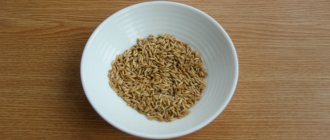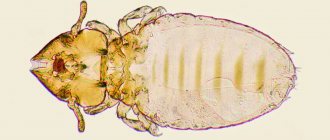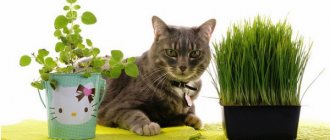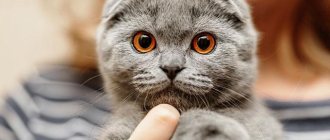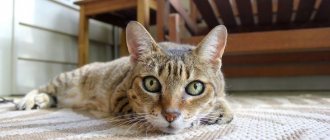Why do cats eat grass?
Scientists have identified several main reasons why cats need to eat grass:
- Vitamins and microelements. Cats are able to bite the tops of blades of grass; they do this to replenish the body with beneficial folic acid, choline, biotin, phosphorus, magnesium, sulfur, zinc, etc.
- Cleansing the stomach from wool. Grass for cats can provoke vomiting, which causes objects, bones or hairs that the animal has eaten by mistake to come out.
- An alternative to indoor plants.
What are the benefits of grass for cats and cats?
Scientists cannot yet unambiguously answer the question of the reason for the emergence of food interest in grass in cats. The following versions seem to be the most plausible:
- Helps in removing undigested food and hair swallowed during licking from the gastrointestinal tract. In its natural habitat, a cat feeds on small rodents and birds, which enter the stomach along with indigestible parts: bones, feathers, claws. In addition, while licking, the animal involuntarily swallows a considerable amount of hair, which, when accumulated, causes discomfort and can lead to diseases of the digestive system. The grass is irritating and can cause vomiting, and as a result, the cat’s body is cleansed, getting rid of undigested residues.
- Supplementing the diet with elements that do not come from food of animal origin. Greens contain useful substances such as vegetable protein, folic acid, B vitamins, and minerals. Cats and cats that eat factory-made food most often do not need grass.
How to grow cat grass at home
A good cat owner who is not indifferent to the animal, if he notices that the pet has begun to eat house plants, will definitely take care of fresh special grass. There are no difficulties with growing plants; you just need to buy seeds and, if necessary, soil. You can immediately purchase a ready-made set, for example, with the name “Alpine Meadows”. Sprouted grass for cats is especially necessary in winter.
Often, owners choose sprouted oats as food for their affectionate pets. It can quickly produce green, juicy grass, but growth requires a greenhouse effect. You can sprout oats at home. It is better to sow the seed in several boxes at once: while the cat eats the first seed, shoots will grow in the second bowl, and shoots will begin to hatch under the lid in the third.
How to choose seeds
Many stores offer grass seeds for cats. You can buy seed on online resources - it’s even more convenient, because the photo clearly shows what the grass is. It is better not to purchase seeds in the markets, especially at low prices, because there is a possibility of purchasing low-quality products or grains treated with dangerous chemicals.
What grass do cats like?
It is generally accepted that cats' favorite plants are valerian and mint. The effect of valerian on cats is usually stimulating, although in some animals valerian, on the contrary, can induce sound sleep. Mint has a calming effect on pets. In such herbs, animals only like the smell; they eat completely different plants. As a rule, cats eat cereals: wheat, green oats, barley, rye. These seeds can be bought at pet stores and grown independently in the countryside. You can also purchase ready-made grass from Grass and Titbit and include it in your cat’s diet.
What grass do cats not like?
If valerian is a favorite plant for cats, then wormwood and onions repel animals. In addition, cats do not like citrus scents, especially lemon. Therefore, if you need to discourage your pet from something, you can place lemon peel nearby. Cats also do not like rue; all felines do not like the aromatic oil and twigs of this plant.
How to plant grass
There are many options for growing plants for cats. If you plan to grow seeds in regular soil, then you need to fill a special container with soil in advance, leaving some space at the top. Then pour out the seed evenly and place a thin layer of soil on it. Before planting, it is best to properly wash the seeds and soak them in water for an hour.
When choosing vermiculite as a growing medium, it should be filled with water along with the seeds for about 40 minutes. After draining the liquid, pour the seeds and base into the prepared germination bowl. You can plant grass for your cat on gauze. To do this, the seeds need to be soaked in cold water (1 hour), after which the liquid is drained, gauze is placed on the bottom of the plate, grains are poured on top and covered with the rest of the cloth.
Without land
The method of growing grass in an artificial environment without soil is called hydroponics. This option for planting plants is very convenient for use at home - the method will protect you from soil scattered around the apartment. To implement it, you will need:
- plastic plates - 2 pcs.;
- any seeds;
- gauze;
- cotton wool;
- plastic bag;
- water.
- Small holes are made in one of the plates so that excess moisture can drain out.
- The holey plate is placed inside the whole one, and a layer of cotton wool is placed on the bottom.
- Pour water over everything, add grain and cover with gauze.
- Water again and cover the plates with a plastic bag.
- After the grain has sprouted, you need to remove the bag.
Into the soil layer
To germinate grass at home, you need to prepare:
- seeds;
- soil (preferably vermiculite, a mineral that looks like yellow plates);
- a container where the grass will grow (pot, deep plate);
- film.
- Before planting, grass seeds should be washed and soaked in water for an hour.
- Pour the soil into a container, leave space on top for the seeds and distribute them evenly on the soil base.
- Add another layer of soil and water.
- Stretch cling film or plastic bag tightly over the container to create a greenhouse effect.
- The mini-vegetable garden is placed on a radiator or cabinet. For 3 days, forget about the existence of plants. The seeds should germinate on the 3rd day, remove the bag after 4 days.
- On day 6, you can safely offer your pet to chew some delicious grass.
- Grown herbs should not be stored for a long time.
What else can you grow?
Cats love plants as well as grass, and they may appear in your cat garden at home. They will not harm the animal, although you need to keep your pet's appetite under control.
This is how you can grow:
- Schisandra – cats like its smell, and the plant itself is healthy to eat. Schisandra is a natural antiseptic, antibiotic and sedative in one bottle, and also helps the animal’s digestion. The plant will switch the cat's attention from other indoor flowers to itself.
- Melissa is also liked by cats, but it must be eaten in strictly dosed quantities, otherwise the animal will face digestive problems.
- Parsley is a curly green that many furry foodies love. It is both tasty and healthy, as it contains many microelements and generally has a positive effect on the cat’s body.
You can also grow cereal crops at home - wheat, oats, rye.
Why do pets need grass?
The grass consumed by pets performs several functions:
- Since pets often wash and lick their fur, it often gets into the digestive organs. And if a hairball gets stuck in the stomach, it will cause digestive problems, since it will not be able to independently move further into the intestines and exit naturally. And the grass irritates the mucous walls and thereby causes a gag reflex, which will help get rid of the stuck lump.
- Juicy grass can help quench your thirst.
- Some varieties of grass contain vitamins, minerals, micro- and macroelements, so this delicacy will be a useful addition to your daily diet.
- The grass contains fiber and fiber that will help normalize digestion (constipation is a fairly common problem among pets, especially those leading a sedentary lifestyle).
- The herb can swell in the stomach, create a feeling of fullness and thereby prevent weight gain, and sometimes this is very important.
It is worth noting that grass is more beneficial for cats, because they are the ones who lick the fur. But it can also be attractive to dogs, although still not in the same way as to representatives of the cat family.
Benefits and harms
Greens contain a large amount of vitamins and minerals, which make the animal’s coat shiny and bones strong. Veterinarians call sprouted oats a cat health resort.
Benefits of the herb:
- for digestion, especially with diarrhea and constipation;
- cleanses the stomach of hairballs;
- for pregnant and lactating cats;
- many vitamins, macro- and microelements.
Harm from sprouted oats will only occur if it is treated with herbicides or pesticides. But at home this is not necessary at all. Although when industrially grown, oats are processed, so it is better to buy seeds and grow them yourself.
How to grow?
How to grow grass for animals? There are several ways.
Method one
To grow grass using this method you will need:
- seeds;
- soil (suitable soil for any indoor plants);
- container (you can grow grass in a pot, in a flat jar or in a plastic container);
- plastic bag or cling film;
- water.
Germination method:
- First, fill the container with soil, but not completely, but halfway, so that there is enough space for the seeds and the second layer of soil.
- Now lightly moisten the soil, then plant the seeds. To ensure that the grass grows evenly, place the seeds at a distance of 0.5-1 centimeter from each other.
- Cover the seeds with soil. The thickness of the top layer should be approximately two centimeters.
- Water the soil a little more so that it is sufficiently moist. Then cover the jar with a bag or film to make an impromptu greenhouse in which growth will be more active.
- Place the container in a warm place and leave.
- When shoots appear, remove the film and water the growing grass as the soil dries.
Method two
You can grow grass without soil, which is very important for animal owners who not only like to eat greenery, but also dig the soil.
You will need:
- two plastic disposable plates (it is advisable to choose one larger);
- seeds;
- cotton wool;
- gauze;
- plastic bag;
- water.
Germination method:
- First, take a smaller plate and make several small holes in it through which water will drain. Place it on a large plate.
- Cover the bottom of a small plate with an even layer of cotton wool, moisten it generously and place the seeds.
- Cover the seeds with gauze on top and water everything again.
- Place the entire structure in a bag to create a greenhouse effect.
- When the first shoots begin to appear, remove the plates from the bag and water the seeds.
Method three
This method can be called quite unusual. To grow you will need:
- a flat and fairly wide container (you can use a cat litter box);
- seeds;
- water;
- cling film.
Growing method:
- You must definitely use a new tray; it should not have any foreign odors. The filler must also be fresh, of course.
- Pour filler into the tray. The layer thickness should be approximately three to four centimeters.
- Fill the filler with water. After about two or three hours the particles will swell.
- Pull back the top centimeter layer of filler, pour in the seeds and fill them in again.
- Cover the container with cling film and place it near a radiator or heater.
- When you see the first shoots, remove the film and continue to grow the grass, watering it regularly.
How and when to give?
How to give grass? In general, animals themselves understand what and in what quantities they need. So you just need to put the container on the windowsill or other convenient place and show it to your pet. You can plant the sprouts about a week or two after planting. Their height should be about 5-10 centimeters. It is these young shoots that attract animals and contain a maximum of useful substances.
If your pet is not used to getting food on its own, then pick a few blades of grass a day and feed them from your hand. This is also worth doing if your pet overdoes it and eats too much grass (this can be harmful).
Remember that if the animal does not want to eat grass, you should not offer it persistently; there is probably no need for it.
Be sure to treat your pet to home-grown grass!
October 19, 2020 Specialization: professional in the field of construction and repair (full cycle of finishing work, both internal and external, from sewerage to electrical and finishing work), installation of window structures. Hobbies: see the column “SPECIALIZATION AND SKILLS”
If you have a cat, then you can only envy you (well, or sympathize with you if the cat is like mine). In any case, a pet requires care, and in the case of a cat, in addition to feeding and care, this also means providing it with fresh grass. Why this herb is needed and how to get it in sufficient quantities, I will tell you in this short note.
Weaning the cat and protecting the flower
A dog may serve its owner, but with a cat it’s quite the opposite. Therefore, convincing her to refrain from eating a dangerous flower is a difficult matter.
There are several recommendations that may be useful to you in solving this problem:
- Remove bowls with “poisonous” plants out of reach.
- Brush the edges of the pot with cinnamon oil.
- Place chopped citrus peels in bowls.
- Place foil near prohibited flowers. Its rustling will scare away the pet.
- Buy anti-rodents at the store and spray the dangerous flowers. The bitter taste will spoil the appetite and the next time the cat will not want to approach the bowl.
Why does a cat need grass?
A cat living in the private sector “free-range” eats grass almost regularly. Of course, there is a risk of helminthic infestations, so deworming must be carried out regularly. But at the same time, grass in the diet of cats (and at the same time canines) performs two extremely important functions:
- Hard grass stems entering the stomach help cleanse it, causing vomiting. Along with vomit and grass, hard-to-digest food remains (for example, a plastic casing from a sausage) and hair that has accumulated inside after licking come out. There is nothing wrong with such vomiting - this process is quite normal and even necessary to maintain the well-being of your pet.
- If the cat only bites the grass stems, chews them and spits them out, this indicates a lack of vitamins. You can adjust the diet, but it is still worth providing access to grass.
As far as I'm concerned about cats, there are no problems with this. But an animal living in a typical high-rise apartment has nowhere to find fresh grass. So you have to periodically raid the owner’s flowers, receiving a well-deserved scolding.
It is possible to protect flowers from a cat, and a cat from flowers (most of them, to put it mildly, are not useful). To do this, it’s worth taking just a little time and growing fresh grass!
Why does a predator need grass?
Cats are by nature predatory animals. This means that the basis of their diet must certainly be meat. However, the cat is not fed up with mice alone. There are many opinions about why pets chew weed.
One of the most popular statements is that animals replenish their supply of vitamins by eating fresh greens. However, a number of studies have shown that this is not entirely true. If a cat were trying to replenish its supply of a certain vitamin, it would taste every blade of grass in search of the right ingredient. But, after observing the musk, you can see that it chews everything indiscriminately, like a goat.
Also, the myth about missing vitamins was refuted after it turned out that the cat’s body is able to independently produce some vitamins that the animal cannot get by eating regular meat.
Consequently, the reason for eating grass has not so much nutritional properties as it carries the unity of murk with nature. This can be seen by how carefully pets treat their “herbal” pots. If the territory allows, they even try to lie on their “indoor lawn.”
Another reason to chew grass is self-medication. Cats with access to walks often regard the lawn as a pharmacy and self-medicate by eating all kinds of weeds.
Scientists have repeatedly wondered what animals can do with herbs. But every time, studies have shown that grass is eaten by both absolutely healthy animals and pets that feel unwell. Therefore, the cat grazes only because he likes it.
What will we grow?
The easiest way is to buy a bag of seeds at the farm store labeled “grass for cats.” As a rule, the seed mixture includes various herbs such as bluegrass, lemongrass, etc. However, even though such grass costs a penny, you can save even more.
Suitable for growing for feeding cats:
- wheat;
- rye;
- oats;
- barley.
By purchasing two or three glasses of such grains at any market, we provide the cat with complete green nutrition for at least a season.
Cat farming technology
Method 1. With soil
There are two ways to grow grass for cats. The first involves the use of a substrate - either regular flower soil or a replacement for it. I usually do it like this:
- I take a tray with a side height of no more than 5 cm: food containers, unused cat litter containers, etc. are suitable. In principle, you can grow grass in flower pots, but here the probability that in the process of eating the greenery will be thrown to the floor is close to 100%. Therefore, the lower the tank and the wider its base, the better.
- I place several layers of thick napkins or hard toilet paper at the bottom of the container.
- Then I add about 2 cm of wood granular cat litter - it is advisable to take the option with a minimum amount of flavorings.
We only use fresh filler! Using pellets that have been in the litter box is: a) unhygienic and b) can harm the cat.
- I fill the filler with water and leave it for about 2-3 hours. During this time, the granules will swell and our substrate will turn into mush.
- I sow the seeds of the halls on the surface of the substrate and sprinkle them with either the same soaked filler or garden soil. The layer of powder should be 1-2 cm.
- I moisten the soil with the seeds and cover the tray with plastic wrap to speed up germination.
- I put our “flowerbed” on . When the seeds begin to germinate, I remove the film and water regularly, making sure that the soil does not dry out.
Method 2. Without soil
The second method does not provide high yields, but it can be used even when we have neither soil nor a suitable tray at our disposal. We proceed like this:
- We take two disposable plates - one larger, the other smaller.
- In a smaller plate we make several dozen holes with a diameter of about 1 mm - they will serve to drain excess water.
- Place cosmetic cotton pads on the bottom of the plate and thoroughly moisten them.
- We place a smaller plate in a larger one, and sow cereal seeds on the surface of the cotton pads.
- Cover the seeds with coarse gauze on top.
We wrap both plates in plastic and place them on the windowsill. As soon as the seeds germinate, the plastic should be removed, and the young grass should be watered at least once or twice a day with a small amount of clean water.
Growing herbs at home
Most herbs work well in a small windowsill garden. The easiest way is to sow seedlings in a flower pot and place them on the windowsill near a light source. Plants need: light four to five hours a day and a constant temperature of 18-22 degrees. Fresh homegrown greens are the perfect base for a delicious dish. How to grow greens if you don’t have a summer house? Those who do not have their own vegetable garden will be without fresh herbal spices. Although there are many different spices on sale, having your own garden on the windowsill is something. In addition to aromas, it lifts the mood with visual perception. Even in the smallest apartment there are ways to realize the dream of having your own herb garden.
Suitable plants
Not every herb is suitable for growing at home. It is best to choose plants that are relatively low maintenance and easy to maintain. If you can't water frequently, choose drought-tolerant varieties. You can also adapt different watering systems during your absence. Those who live in a poorly lit apartment also need to consider additional lighting or buy shade-loving plants. Garlic and parsley, for example, can grow with little light and are therefore well suited to dark rooms. Parsley grows slowly and it will take a long time before the first harvest. It is better to prune it rather than pull it out by the roots in order to get the next harvest faster. Oregon, basil and rosemary are also easy to care for. But they require a lot of sun, so it is better to grow them on the south side, where there is a lot of light. If there is not enough space on the windowsill for plants, you can also find a solution in the form of shelving with built-in lighting.
Multi-tiered solution on the balcony
If you want to grow herbs, transplant the plants immediately after purchase or sow them in large pots. Because often the pots they are sold in at garden centers or supermarkets are too small. Young grass roots do not have enough space to grow fully. Spicy herbs are used frequently; as a rule, they do not require much water. So, in order to avoid waterlogging of the roots, it is better to use small shards or expanded clay at the bottom of the pots as drainage. Expanded clay absorbs excess water and returns it gradually when the ground is dry. Also, too much heat can damage plants and quickly dry out the soil. It is better not to place pots close to heat sources. If you don't have time to use or want to dry excess herbs, cut out no more than half so that the other half continues to grow. In this case, you will always have fresh greens. Do you have a balcony? It is great for growing herbs in the summer. Do you only add salt and pepper to your dishes as spices? Then you should definitely try fresh herbs. Spicy herbs make it possible to easily and quickly raise your spirits. They give the dish a herbal, spicy and interesting taste and aroma. Fresh herbs are necessary spices in everyday life: parsley, green onions, dill and other herbs can be quickly collected at any time in the right quantity and chopped into the desired dish. Fresh herbs on the windowsill or in the garden are always at hand and can be harvested according to personal preference. How to use fresh herbs skillfully and what the alternatives are, draw your own conclusion.
What grass do cats like?
A completely indoor pet that does not have access to the outdoors will look for options to meet its needs. The first victims will be indoor flowers and seedlings on the windowsill. Some individuals do not disdain bouquets and even chew on a broom. And they do this out of need, and not out of self-indulgence. The owner’s task is not to swear, but to provide the cat with grass.
Cats love plants such as valerian and mint (another name is catnip), but not because of gastronomic preferences. These are rather medicinal plants that are useful for correcting behavior, eliminating stress, and anxiety.
Herbs: what's with what?
Those who use fresh herbs in their dishes consume less salt. And salt, as we know, retains water in the body. Due to their high mineral and vitamin content, herbal mixtures make an important contribution to a healthy diet. The valuable ingredients are preserved in most fresh herbs. Before use, it is enough to rinse them under running water without heat treatment.
Herbs commonly used in cooking
- Basil goes well with almost all Mediterranean dishes. It affects appetite and has a detoxifying effect. Fresh leaves can be chewed for fresh breath. Basil comes with green, purple and violet leaves. It belongs to the mint family of plants and gives dishes a piquant, spicy taste and aroma. Used in salads and as a decoration, the velvety leaves look wonderful. Excess basil can be easily frozen: chop the leaves, mix with a little olive oil, seal the jar and freeze.
- Green onions are like a miracle of nature, thin stems emerge almost like from a construction set. Their taste is a little hot. They can be used raw in salads and sauces. If you want to get feathers rich in vitamins, under no circumstances grow onions in water, plant them in the ground!
- Wild garlic is better than regular garlic, it does not smell. The taste of the dish is better with wild garlic. It contains iron, accumulates in the blood, lowers blood pressure and strengthens the heart.
- Savory strengthens the stomach, promotes digestion and invigorates. Savory is often used in legume dishes. It combats the gas-producing side effect of legumes. Savory helps digest starchy foods and game. Whole branches are added to the pot when cooking and achieve a good aroma.
Important! Don't confuse savory with thyme!
- Borage, also known as borage, resembles the taste of cucumber with a hint of onion. It is considered as a diaphoretic, diuretic, and cardiotonic. Contains a lot of potassium, ascorbic acid, organic acids, carotene. It is a substitute for cucumber; it is added to various salads, sauces, hot dishes, and cold vegetable soups. Borago adds a piquant taste to fish, minced meat, and minced meat. It is also used as a flavoring for various drinks.
- Burnet has a mild, cucumber-like flavor that is ideal for herbal sauces and salads. Borage herbs have a similar taste. Applies to fish, drinks and sauces. Young burnet leaves are used for canning. The leaves are used in cooking in soups, salads, egg and fish dishes, cocktails, and drinks. The roots are boiled and used as a side dish. The leaves and roots are brewed as tea.
- Watercress salad tastes very similar to horseradish; to some it reminds a little of radish. It has a savory taste and is applied to dairy products, eggs or chicken. It contains a lot of vitamins and strengthens the immune system. There are different types: curly, with narrow and with regular leaves of different ripening periods. It is eaten both raw and with meat dishes. Especially in the West, watercress is widespread. In our country, watercress salad has also become very popular recently.
- Rucolo has a peppery-spicy and sour-fresh taste. Stimulates appetite and digestion. Great for salads, but also for risotto, pasta or fish.
- Dill stimulates appetite and relieves indigestion. It is ideal for cucumbers and fresh fish, especially salted sea fish. Dill has been used since ancient times in cooking and is the most common herb in the kitchen. Harvest time is early summer. It can be dried and frozen. Stores in the freezer throughout the year. The seeds are used in Indian and South American cooking. When salting, we cannot do without this plant. Dill is said to calm the nervous system.
- Parsley is suitable for almost all dishes. It is rich in provitamin, vitamin B, B2 and calcium. Parsley stimulates the kidneys, purifies the blood and aids digestion. Parsley comes in regular and curly varieties. It is compatible with all other spices and goes well with almost any dish. It is often used to decorate dishes, adding a fresh look and rich taste to stews, meats and many other products. Regular parsley has a richer flavor than curly parsley.
- Oregon is used in many sauces. It's hard to imagine Italian pizza and herbal mixtures without it. You can also use a sprig of Oregon with cheese. Even when dried, the aroma remains if stored in a closed jar. Oregon's spicy, slightly tangy flavor lends itself well to salads. Oregano (the second name) has a tart, slightly peppery taste and is used a lot in Italian and Greek cuisine. Promotes appetite and calms nerves.
- Rosemary smells wonderful! The branches are narrow, needle-shaped, reminiscent of a green forest. Rosemary is a versatile herb that goes well with poultry and pork, both for roasting and baking. Contains many essential oils that stimulate appetite. In a pot it gives the feeling of a Mediterranean garden. Rosemary will relieve headaches, calm the nervous system, and have a positive effect on the gastrointestinal tract and bile excretory activity.
- Thyme goes best with meat and potato dishes. Oddly enough, thyme, unlike many other herbs, is stronger than fresh. Thyme has a spicy-sweet taste and its wonderful aroma only develops when cooking. It has a calming, antispasmodic, expectorant effect.
- Tarragon has a high content of essential oils, which have a spicy-bitter taste. It stimulates appetite and gastric juice secretion. Used for main dishes of pork, lamb, beef.
- Wormwood is an ideal herb for rich and satisfying dishes, adding piquancy. It stimulates the bile flow and thereby guarantees optimal fat digestion. Only the young upper leaves of wormwood are consumed before flowering. Often used for the production of liqueurs. There are countries where they bake bread with the addition of wormwood and juniper berries.
- Chervil stimulates metabolism, cleanses the blood and removes toxins. It has a slightly spicy flavor with parsley and vanilla aroma, fresh leaves and stems are used for a slightly sweet aroma. It is good for dietary soups, eggs and poultry dishes. Perfectly harmonizes with crabs and even Frankfurt green sauce. In Sweden they produce cognac with fresh chervil and vodka. Chervil is used only in its green form. It should be added to the dish immediately before serving. Chervil greens are a good source of ascorbic acid, protein, vitamin C, glycosides, mineral salts, provitamin A. It lowers blood pressure and improves digestion.
- Coriander is a typical herb for Asian cuisine and has a slight aniseed flavor. It is suitable for creamy dishes, promotes appetite and relieves bloating.
- Lovage is used primarily in soups and stews, confectionery and beverages. Even a small amount can impart a special mushroom flavor to canned food. It has a diuretic effect and is therefore beneficial for the kidneys and bladder. Often used in dietary nutrition.
- Marjoram goes great with meatballs or fried potatoes. It has a particularly calming and relaxing effect on the gastric mucosa. Marjoram is used in almost all German sausages because of its powerful, spicy flavor. And potatoes are wonderful with marjoram. It comes to us from Mediterranean cuisine and can be used for all hearty dishes.
- Mint is suitable as a standard garnish for desserts and mixed drinks, as well as for meat, fish and yogurt sauces. Peppermint essential oils stimulate the secretion of bile and soothe the stomach and intestines. The taste of green leaves refreshes the taste of salads and new potatoes. There are different types of mint, the most famous being peppermint.
Tip: To quench your thirst, brew fresh mint, it’s delicious!
- Dried bay laurel is available in every kitchen. Stewing and preparing sauerkraut is hardly possible without an intense taste. The evergreen bay bush can be grown as a houseplant.
- Nettle is used raw, but scalded briefly to prevent it from stinging. The taste is similar to spinach. Nettle is rich in vitamins, minerals, and is useful in building blood support. Cabbage soup is made from young nettles. Try the nettle dumplings.
- Balsam (Censer Sarmatian), young leaves give yogurt and other dairy products a fresh flavor. Its taste is reminiscent of lemon, although the leaves are similar to nettles. Censer lemon balm is added to various drinks and balms.
Mint and thyme can also be added to tea for taste and as a garnish for various drinks. Herbs not only look beautiful, but they also taste great in food. As you can see, many herbs have healing and health benefits. You decide what kind of grass to grow on your windowsill based on your own preferences. Remember that in nature the greenery is caressed by the wind. Do not place pots too tightly so as not to interfere with air movement. For those who read the article to the end, a recipe for a special oil.
Homemade herb oil
You might have seen oils with herbs on store shelves. They are not cheap. You can easily make your own herb oil. Simply add the desired aromatic herbs to the oil bottle and leave to ripen in a dark place for 4 to 6 weeks. You can use a variety of fresh or dried herbs and create an oil to suit your taste. Fresh herbs contain more flavor than dried herbs because the essential oils are lost during drying.
Oils with various herbs
The world is slowly awakening from the nightmare of marijuana prohibition, but today in most countries of the world, growing cannabis can get you into very serious trouble.
Even where medical or recreational marijuana is legalized - and there are more and more such places every year - there are restrictions, for example, on the number of bushes, so it is safer to grow in silence and not “get burned” in front of others.
Our advice will help you with this.
Smell
The Dutch called one of the early varieties of indoor hemp skunk (that is, skunk) and for good reason. The most fragrant varieties begin to make themselves known in the vegetative stage, and at the flowering stage the smell stings the eyes. Therefore, it is imperative to arrange exhaust ventilation in the room.
* Calculation example: Wardrobe with an area of 60x80cm and a height of 1.5m. Multiply 0.6 x 0.8 x 1.5. We get 0.72 m3. Multiply by 100. We get 72cfm. It's minimum. Or multiply by 175. We get 126cfm. This is the very thing.
Ventilation not only removes odors outside the room, but also supplies plants with fresh air, without which they will never realize their full potential.
An activated carbon filter is often used in conjunction with a duct fan. Please note that the carbon filter does not work as effectively at high temperatures, so try to keep the air temperature within 25 degrees. If you have a large room and there are doubts that the hood is sufficient, install two lower-power fans instead of one large one. Among other things, this will allow you to use two filters at once, which means you can not only cool the air faster, but also clean it more efficiently.
Unwanted noise
Often, growers lose sight of this issue, excitedly filling the room with lamps, fans, hydraulic pumps, etc. and not thinking that the vibration and buzzing goes straight to the neighbor below. Or from above. Or from the side. And what’s much worse, the neighbor will hear these sounds for 18 hours a day, until finally his patience runs out and he calls the police. There are times when equipment noise can be heard even through a window or door.
Using foam mats is a good way to cut out vibration and noise, and acoustic ducts will make ventilation less noisy. (Just keep in mind that some acoustic ducts leak air from the pipe into the surrounding insulation, thereby negating your odor control efforts!) Also remember that some of the equipment that will run 24/7 includes box fans, hydroponic pumps, and aerators. etc. In general, there are a lot of things to consider when you live in an apartment or in a house with neighbors.
Suspicious neighbors
In general, there can be a lot of problems with neighbors, since not everyone correctly understands our hobby. One suspicious and observant neighbor, and the whole street will gossip about you, and you won’t even know about it. Live in harmony with your neighbors, and perhaps they will express all their suspicions to you, and not to someone else.
Waste
If someone looks through your trash, they might have a pretty detailed idea of what you're up to. We are talking about empty fertilizer bottles, soil bags, empty pots, roots, stems and leaves, as well as seed packets. So always think about what and where you throw away.
It's a good idea to make a compost pile in your backyard. Coir, soil, root mass, stems and leaves can be thrown here. Hemp is an excellent compost material because it is full of nutrients absorbed from the soil or other substrate. If you're growing your hemp organically, creating your own compost is an ideal way to get rich soil for future plantings.
"Tricky socket"
From time to time, growers are caught stealing electricity by bypassing the meter. As a result, they are punished for growing, and the electricity supplier also brings a civil lawsuit against them. Even if you grow for yourself, think about the savings that avoiding purchased buds gives you - it will more than pay for any expenses. Those who steal electricity also cast a shadow on honest growers (which are the majority).
Trips to the grove site
Maybe you grow in the same place where you live, or maybe in a special room or on a separate plot of land. In any case, remember that you may be watched from the outside. It will be suspicious if you visit a house or apartment regularly, but always for an hour a day. In addition, you will bring land, equipment, fertilizers, etc. here. Choose the most “light-free” time of day and try not to attract attention.
The same applies to artificial darkening - it will force you to visit the plantar twice a day. There's not much you can do here, but at least keep your eyes open.
Grow at night
There are many benefits to growing cannabis at night. Not only is it cooler at night, but everyone around you is asleep. Your grow box will be quiet during the day and buzzing at night. None of the neighbors will even know that a ventilation system is making noise somewhere nearby. Setting the lights on at 10pm and off at 10am will help you cope with the heat in the box, which is especially important during the summer months.
